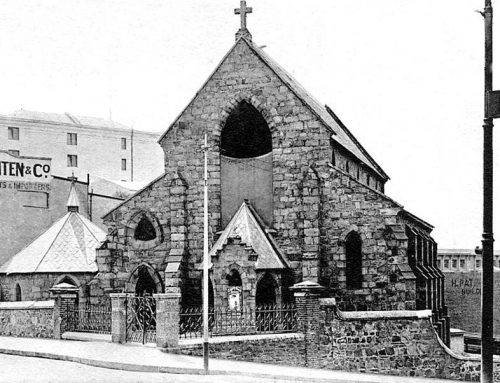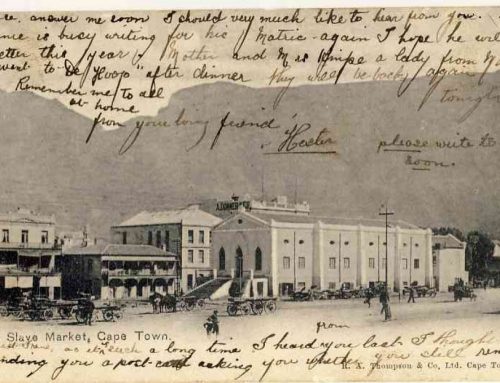
The Anglican Church at Springbok, Namaqualand is the oldest Anglican Church and one of the oldest buildings in the district, yet after one hundred years, it is still incomplete. It seems clear from the flat top of the gable at the West end of the Church that a stone arch was originally intended to be built above this gable, to hold the bell. Only this year the holes, left open for joining the walls of a porch over the South door of the church, have been filled in. The vestry inside the main building rather spoils the interior, but there appears to have been no intention to add a vestry when the church was built.
The furnishings have not worn as well as the building and, in order to provide for all these things, and to surround the churchyard in a more worthy manner, a Centenary Fund has been opened to which all collections and donations received during the Centenary will be added.
The Altar, reredos, curtain, canopy, and sanctuary carpet are all modern, having been put in to adorn the Church for the Centenary. The only decoration of historical interest in the Church is the Altar Cross which is of brass set with rare stones and was given in 1903 by officers and men of the Cape Mounted Police.
The Congregation is older and more important than the Church building. The first “curate” was the rev. Henry Whitehead who was in office by September 30th 1856 when he solemnised the first marriage “at Springbokfontein in the district of little Namaqualand” between John Wolstenholme, widower, a baker of full age, and Hendrina Johanna Mostert, spinster, aged 23 years. The couple came from Kamiesberg and the groom’s father is described as a Copperas Manufacturer while the bride’s father was a farmer. The witnesses were George Cooper and Mary Rutledge. If Mr. Whitehead had been a marriage officer today, the certificate would have been returned, as two different spellings of the groom’s surname and of the bride’s Christian names appear. 1858 was a good year for marriages; there were seven that year and none in 1859. Two of the 1858 brides were widows, aged 19 and 27, a sad commentary on the sort of conditions in which people must have lived in those days.
The Church was built two years after Mr Whitehead left when the Rector was the Rev W.J.R. Morris (whose grandson was later to become rector). The Rev W.J.R. Morris designed and built the Church, and it is only from Mr. Morris’s time that we have complete records of Baptisms and burials.1 The first Baptism was that of Eliza Maria Gould on August 23rd, 1863, and the first burial that of Jantjie Gertze on April 11th, 1864. It is fascinating to look through these old registers. Not only do well-known names appear over and over again, but the ages of the people who were buried speak for themselves. On some pages recording burials in the 1860’s as many as half the dead were infants. In the Baptism Register, there is a column which records the “quality, trade or profession of the father.” What sort of people were the members of the Church in those days.
George Gould, trader
Thomas Griffiths, blacksmith
Henry Wechler, ostler
William Davis, builder
Thomas Smith, miner
John Wolstenholme, farmer
This is the same John whose marriage was the first to be solemnised. His daughter Margaret, was born on August 15th 1863 and baptised six weeks later.
Then there is John Townsend, Merchant and Frederick Rutledge, Shopkeeper (doubtless a subtle difference!); John Howe, Gentleman; Spenser Innes, General Agent; Edward Judge, Civil service; Samuel Gifford, Captain of Mine; George Shaw, Conductor of Mule Train. And so the story goes on. Edward Judge had become Resident Magistrate by 1865 when his next child was baptised.
In any church which retains the three traditional orders of Bishops, Priests and Deacons, the Bishop must visit each congregation from time to time, to administer the Sacrament of Confirmation. For a place a remote as Springbok used to be, these Episcopal visits are landmarks. Bishop Gray, first Bishop of Cape Town, first visited Springbok, Namaqualand in 1866, when he confirmed four people on May 8th, the oldest being 41 years old. He then went to Hondeklip Bay where he confirmed five people on May 13th, so that he evidently took four days for the journey.
Bishop Gray’s second visit was in 1871 just after his wife had died. She was devoted to him and had accompanied her husband to Springbok on his first visit making notes and sketches along the way. Finding his way to Springbok again without her, the Bishop wrote nostalgically that his only guide “over a great part of the Journey is a tracing of the country with all the information connected with it in her dear hand. She was bent on making this journey with me.”
The Bishop went to Port Nolloth on his second visit where he confirmed four people, and twelve days later – he had been ill during this time – confirmed 23 people at Springbok, two of whom were 50 years old.
 And so the Church grew. Bishop West Jones came in 1875, 1877, and 1890. Bishop Gibson in 1896 and Bishop West Jones again in 1898. When snow fell a few weeks ago at Nababeep it caused quite a stir. Bishop West Jones encountered snow for the first time in South Africa on his visit to Springbok in July / August, 1898.
And so the Church grew. Bishop West Jones came in 1875, 1877, and 1890. Bishop Gibson in 1896 and Bishop West Jones again in 1898. When snow fell a few weeks ago at Nababeep it caused quite a stir. Bishop West Jones encountered snow for the first time in South Africa on his visit to Springbok in July / August, 1898.
There has always been a spirit of friendship and co-operation between the different denominations in the Parish, even if there has been friction occasionally. We have a letter from Bishop West Jones dated December 4th, 1890 – alas the stamp has been torn off the envelope written to a Mr Brock saying that Mr Morris has given the Wesleyans permission to use our cemetery. He advised this should go on provided that they realised the cemetery did not belong to the Wesleyans and that they should always ask permission before using it. Apparently at one stage the cemetery gate had been locked “and that more than once the lock has been forced or the staple removed by persons desirous of obtaining access to the ground for the purposes of burial.” The Bishop tells Mr Brock not to allow “such violent intrusion.”2
The records indicate that from the earliest days, services were held in both English and Dutch. The tenth marriage solemnised by the Rev. Henry Whitehead, on July 12th 1858. has one copy of the register in English and the other in Dutch.
“Dit Huwelyk is voltrokken tusschen ons
P.A. Esterhuizen
Katrina Maria Janetta van den Heever
haar X merk.”
There was an unusually large congregation in Springbok, Namaqualand when the Rev. Walter Richardson preached on “The Children of God” on Thursday February 19th, 1903. 75 people were present and the collection was £1.5s.41/2d. for the preacher, 1/- for the driver. This was a bigger congregation than on Easter Day the same year but the reason is not evident. There are records of services being held regularly in English and Dutch. The last Dutch entry is on October 1st, 1933, when the Rev. C.G. Green conducted Dutch Evensong at 4 p.m. They kept All Saints’ Festival on Sunday October 29th, when the same priest celebrated Afrikaans Eucharist at 7.30 a.m. 26 people received Communion and the collection was 3/3d.
The Anglican Church has always been a pioneer in the field of education. The first school at Springbok, Namaqualand was opened in 1865 and conducted in an old building near the open mine. Mrs Kwaza, wife of a Fingo interpreter, was one of the first schoolmistresses. The present school building came into use this year while the previous one was completed in 1941. There is a loose slip of printed paper, undated, between the pages of the burial register for 1871 which is evidently some kind of statistical return. It asks:-
No. (total) at present in the school able (a) to say the Lord’s Prayer
- do. (b) do. Creed
- do. (c) do. Ten Commandments
- do. (d) do. Church Catechism
- do. (e) do. to read the Bible
It seems a far cry from those days but what we have been able to do has been built on the foundations laid over the last hundred years. We look back with interest, occasional amusement and, above all, gratitude to the achievements of those who have gone before us and look forward in faith and hope as we continue the work for God’s Kingdom so nobly begun.
Acknowledgements and sources.
Parish Registers
Parish of Namaqualand Centenary Leaflet 1852 – 1952 by the Rev. J.W.L. Lavis
Letter from the Ven. W.V. Gregorowski, October 1964
Letter from the Rev. L.R. Morris, October 1964
Written by Guy Barker[facebook] [twitter name=”name”]




